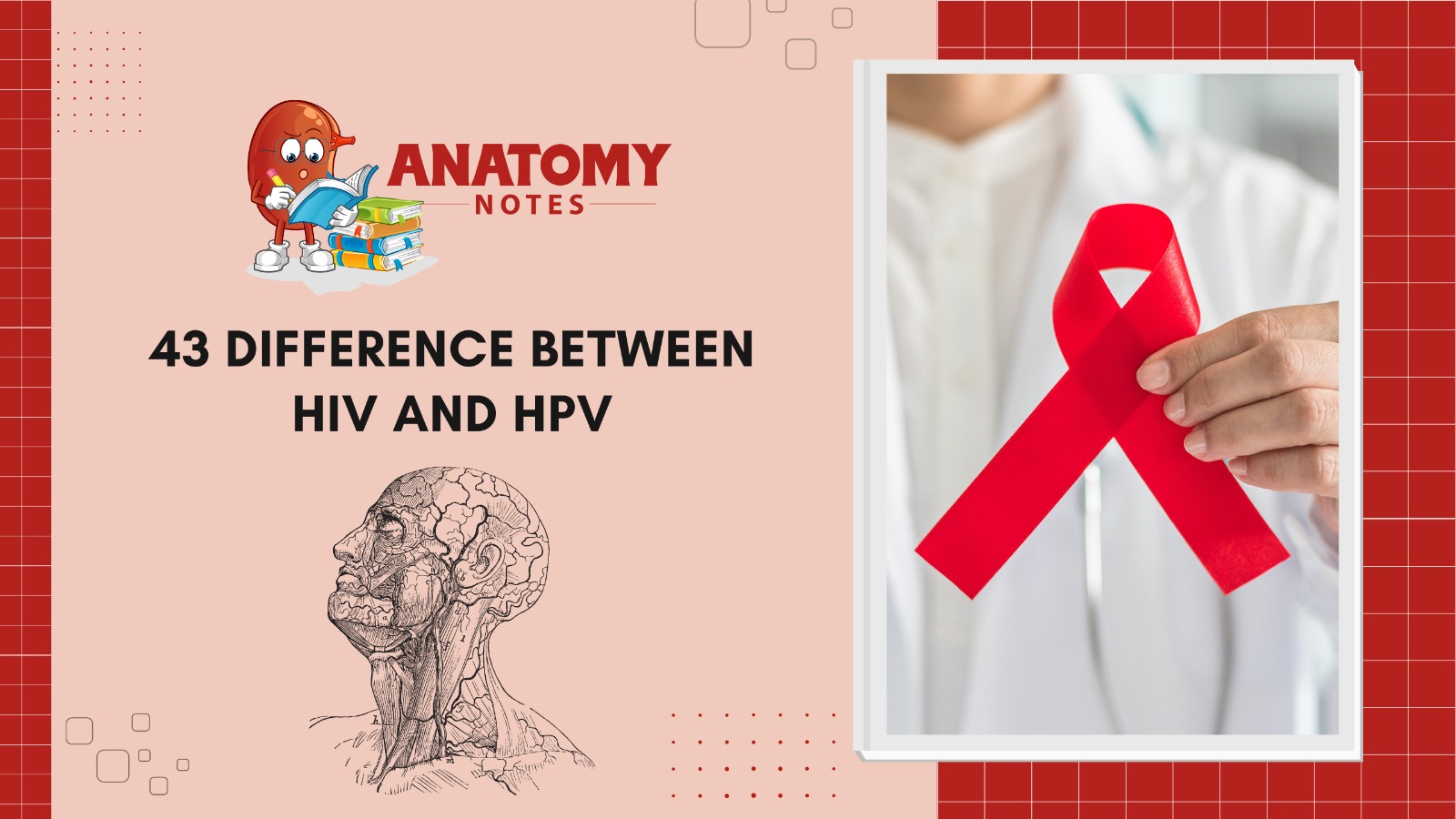The infectious illness world knows HIV and HPV. Each represents an essential health concern. Millions of individuals worldwide suffer from HIV and HPV. Despite their titles, these viruses propagate, damage the body, cause diseases, and are difficult to stop.
The immune system is usually affected by HIV, which causes AIDS. It targets immune-boosting CD4 cells. The body struggles to combat infections and illnesses. HIV spreads through unprotected sexual contact, IV drug sharing, and maternity or breastfeeding. Using filthy blood in transplants might potentially spread it. Viruses damage the immune system, rendering people more susceptible to various diseases like cancer. HIV has no cure despite antiretroviral medication. Treatment emphasizes viral management and immune system health.
In contrast, HPV attacks the skin and nasal tissues. HIV has few varieties, whereas HPV has numerous. Some strains produce skin warts, while others are sexually transmitted and can cause genital warts and malignancy. HPV is transferred by personal contact, usually. Most people worldwide contract it through physical touch. HPV illnesses usually heal on their own. Long-term high-risk HPV infections can cause cervical, anal, oropharyngeal, and other malignancies. The most deadly HPV kinds are protected against cancer by vaccines.
A major distinction between HIV and HPV is the health effects. HIV primarily weakens the immune system. Advanced HIV patients are more prone to get serious opportunistic infections. Unlike HIV, HPV does not directly affect the immune system and can cause genital warts and certain cancers.
Problem-solving methods differ too. Avoiding needle sharing and using condoms can reduce HIV risk. HIV patients’ viral loads and health can be improved with antiretroviral medication. In contrast, HPV vaccination is one of the best strategies to prevent infection and cancer. Men and women should obtain HPV vaccines before dating.
HIV and HPV are two separate viral disorders with different effects, spreads, pathologies, and prevention methods. HIV causes AIDS by attacking the immune system. Genital warts and cancer can result from HPV’s skin and mucous effects. To avoid, cure, and protect the public from viral infections, you must understand these changes.
Also Read: An Overview of the Lymphatic System’s Function & Organs
Here are the 43 differences between HIV (Human Immunodeficiency Virus) and HPV (Human Papillomavirus):
|
S.No. |
Aspect |
HIV |
HPV |
|
1 |
Full Name |
Human Papillomavirus |
|
|
2 |
Type |
Retrovirus |
DNA Virus |
|
3 |
Transmission |
Primarily through blood, sexual contact, sharing needles, and mother-to-child transmission during childbirth or breastfeeding |
Mainly through sexual contact, but also through skin-to-skin contact, including non-sexual contact |
|
4 |
Target Cells |
Attacks immune system cells (CD4 T cells) |
Infects epithelial cells in the skin and mucous membranes |
|
5 |
Disease Caused |
Can lead to AIDS (Acquired Immunodeficiency Syndrome) |
Various conditions, including genital warts, and can lead to cancers, such as cervical cancer |
|
6 |
Vaccine Availability |
No cure or vaccine available |
Vaccines available to prevent some HPV strains that cause cancer and warts |
|
7 |
Cancer Association |
Can increase the risk of certain cancers, such as Kaposi’s sarcoma and lymphomas |
Known to cause various cancers, including cervical, anal, and oropharyngeal cancers |
|
8 |
Prevalence |
Worldwide epidemic, especially in Sub-Saharan Africa |
Extremely common; most sexually active people will have at least one HPV infection in their lifetime |
|
9 |
Transmission from Mother to Child |
Can be transmitted during childbirth or breastfeeding |
Can be transmitted during childbirth, but not through breastfeeding |
|
10 |
Immune System Impact |
Weakens the immune system over time |
Typically does not affect the immune system in the same way |
|
11 |
Treatment |
Antiretroviral therapy (ART) to manage the virus and slow disease progression |
No specific antiviral treatment for most HPV infections; focus is on managing symptoms and preventing complications |
|
12 |
Sexual Transmission Risk |
Primarily through unprotected sexual intercourse, including anal and vaginal sex |
Primarily through sexual contact, but also through non-sexual skin-to-skin contact |
|
13 |
Incubation Period |
Varies, but it can take years for symptoms of AIDS to develop |
Can range from months to years; some HPV infections may clear on their own |
|
14 |
Testing Methods |
Blood tests for detecting antibodies and viral load |
Swab or biopsy of infected area for detecting specific HPV strains |
|
15 |
Transmission from Skin-to-Skin |
Not typically transmitted through skin-to-skin contact |
Can be transmitted through skin-to-skin contact, including hand-to-genital contact |
|
16 |
Oral Manifestations |
Can cause oral thrush and other oral conditions |
Can lead to oral warts and oropharyngeal cancers |
|
17 |
High-Risk Strains |
HIV is a single virus with different subtypes, but no specific “high-risk” strains |
Several high-risk HPV strains known to cause cancer |
|
18 |
Low-Risk Strains |
No distinct “low-risk” HIV strains |
Several low-risk HPV strains responsible for genital warts |
|
19 |
Condom Protection |
Effective in reducing HIV transmission if used consistently and correctly |
Can reduce the risk of HPV transmission but may not provide complete protection due to skin-to-skin contact |
|
20 |
Natural Clearance |
HIV does not naturally clear from the body |
Many HPV infections naturally clear within a couple of years |
|
21 |
Prenatal Screening for Mothers |
Pregnant women are often screened for HIV to prevent mother-to-child transmission |
Prenatal screening for specific high-risk HPV strains may be recommended, but no treatment is available for the virus itself |
|
22 |
Chronic vs. Acute Infection |
HIV is typically a chronic infection that lasts for life |
HPV infections can be acute (temporary) or chronic (persistent) |
|
23 |
Cancer Prevention Methods |
Early HIV detection and antiretroviral therapy can reduce the risk of associated cancers |
HPV vaccination and regular screenings (e.g., Pap smears) can help prevent HPV-related cancers |
|
24 |
Autoimmune Diseases |
HIV can lead to autoimmune diseases as the immune system weakens |
HPV infections do not directly cause autoimmune diseases |
|
25 |
Global Impact |
Affects millions of people worldwide with significant public health challenges |
Widespread but usually less severe impact on public health compared to HIV |
|
26 |
Protective Behaviors |
Safe sex practices, needle exchange programs, and pre-exposure prophylaxis (PrEP) can reduce HIV transmission risk |
HPV vaccination, condom use, and regular check-ups can reduce HPV transmission and related complications |
|
27 |
Progression to AIDS |
HIV can progress to AIDS without treatment |
No equivalent “AIDS” stage in HPV infection |
|
28 |
Relationship to Other Infections |
Co-infection with other sexually transmitted infections (STIs) is common |
Can co-occur with other STIs, but not directly related to immune suppression like HIV |
|
29 |
Impact on Pregnancy |
Can affect pregnancy outcomes and may require special care during pregnancy |
Generally does not impact pregnancy outcomes, but prenatal screening may be recommended |
|
30 |
Herpesvirus Connection |
Not related to herpesviruses |
Some HPV strains can lead to genital warts, which are different from herpes |
|
31 |
Association with Injection Drug Use |
Higher risk for transmission through sharing needles among injection drug users |
Not typically associated with injection drug use |
|
32 |
Global Response and Funding |
Significant global efforts and funding to combat the HIV epidemic |
Less global funding and response compared to HIV, especially in lower-resource settings |
|
33 |
Virus Structure |
Enveloped virus with RNA genetic material |
Non-enveloped virus with DNA genetic material |
|
34 |
Mutation Rate |
Higher mutation rate, leading to viral diversity |
Lower mutation rate, resulting in less genetic diversity |
|
35 |
Complications |
Opportunistic infections, immune system-related diseases, and AIDS-related complications |
Genital warts, cervical dysplasia, and HPV-related cancers |
|
36 |
HIV Stages |
Early infection, chronic asymptomatic stage, symptomatic HIV, and AIDS |
No distinct “stages” like HIV; can manifest as acute or persistent infection |
|
37 |
Co-Infections |
Increased susceptibility to other infections due to weakened immune system |
Co-infection with other STIs can occur, but not directly related to immune suppression like HIV |
|
38 |
Immune Response |
Progressive weakening of the immune system |
Typically does not result in progressive immune system weakening |
|
39 |
Antiviral Medications |
Antiretroviral therapy (ART) is the primary treatment |
No specific antiviral medications for most HPV infections |
|
40 |
Asymptomatic Infection |
Can be asymptomatic, especially in early stages |
Often asymptomatic but can lead to symptoms and complications over time |
|
41 |
Relationship to Other Diseases |
No direct link to specific cancers other than Kaposi’s sarcoma |
Known to cause several cancers, including cervical, anal, and oropharyngeal cancers |
|
42 |
Public Awareness and Education |
Extensive public awareness campaigns and education efforts worldwide |
Public awareness efforts primarily focused on HPV vaccination and cancer prevention |
|
43 |
Impact on Life Expectancy |
Can reduce life expectancy without treatment |
Typically does not significantly impact life expectancy unless complications arise |
Also Read: 34 Difference between Umbilical Cord and Placenta
Frequently Asked Questions (FAQS)
Q.1 What is the primary mode of transmission for HIV and HPV?
HIV is mostly spread through unprotected sexual contact, needle sharing, and breastfeeding. HPV is spread by skin-to-skin contact, especially sexual contact. Most sexually transmitted infections worldwide are it.
Q.2 Can HPV and HIV be cured?
HIV has no treatment. However, antiretroviral medication can manage the infection, lower viral load, and boost immunity. High-risk HPV infections can cause cancer, although most resolve on their own. HPV has no cure, however vaccinations for high-risk strains reduce the incidence of related malignancies.
Q.3 What health risks do HIV and HPV pose?
HIV causes AIDS by attacking the immune system. This immune system weakness makes people more prone to opportunistic infections and malignancies. HPV infections can cause genital warts and cervical, anal, and oropharyngeal malignancies.
Q.4 Are there any preventive measures for HIV and HPV?
Preventing HIV transmission requires condom use, needle-sharing avoidance, and PrEP for high-risk persons. HIV can be managed with antiretroviral treatment. HPV is preventable via vaccination. Both men and women should get HPV immunizations before sexual activity. Cervical cancer checkups like Pap smears are very crucial.
Q.5 Are HIV and HPV the same thing?
HIV and HPV are separate viruses with different impacts and transmission methods. HIV assaults the immune system and causes AIDS, whereas HPV affects the skin and mucous membranes, producing genital warts and cancer. These distinctions must be understood to prevent and treat each illness.




